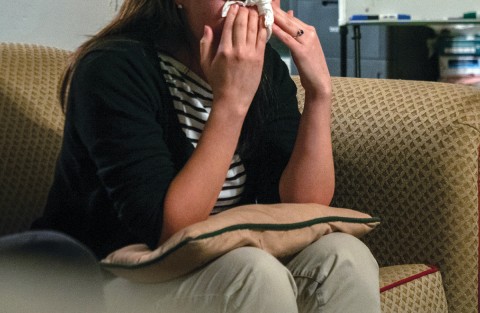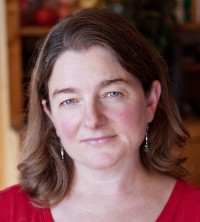Asylum seekers face nearly impossible hurdles. The Dilley Pro Bono Project tries to help.
A week with 12 law students volunteering in South Texas

The sun was setting when Tatiana Alonso headed out from the Best Western Hotel in Dilley, Texas, this January with 11 of her classmates from the Chicago-Kent College of Law. The students had arrived in this small, remote town in South Texas for a week of volunteering at the South Texas Family Residential Center, where they hoped to provide legal support to the women and children being held at the federal detention center.
The students were going to a ranch to receive an orientation for their work with the Dilley Pro Bono Project. They drove under Interstate 35, busy with oil field traffic. They passed the Briscoe Unit federal prison on their left. Just beyond the prison, barely visible at the horizon, amidst brush and red dirt, were the tentlike awnings of the detention center.
Read our latest issue or browse back issues.
The ranch felt like a secret hideout, just a few hundred yards from the detention center grounds. They gathered there in the near dark amid mesquite, juniper, and oak bushes. The white cement blocks of the ranch house were splattered and streaked with red dirt. Someone had collected the bones of animals from the area and piled them on windowsills. There were bicycles brought and then abandoned, said DPBP advocacy manager Katy Murdza, by naive and enthusiastic people who thought one might want to bicycle around here. A note on the refrigerator from a former staff member said, “I will be back for my bike.” She had not returned for it.
Alonso was the leader of the group. This was her third trip to Dilley and the first time that she was leading others into the difficult work of meeting with women who have been detained and helping them in the process of seeking credible fear interviews and hearings in front of judges via closed-circuit television.
She knew the work to be grueling. Her first year, she said, “we spent 12 hours a day in the detention center listening to stories of rape, assault, killings, torture that these women have experienced in their home countries and with their children, who have been witnesses to it. Or maybe their children were no longer with them; they had to leave them behind because it was the only way to survive. It was really difficult because they warn you about secondhand trauma and it is a real thing, but until you go down there and experience it, do you really know?”
Yet the experience was powerful enough that she had wanted to return and to ensure that the program continued. “I am the daughter of Mexican immigrants, and I know—I’ve lived through—I know what it is to live in a household where not everybody has legal status. That has shaped who I am and has motivated me to want to become an attorney, specifically an immigration attorney.” She has helped to organize an immigration clinic at her home law school and now has organized students to share the experience at the detention centers.
The first family detention center opened in Artesia, New Mexico, in 2014. The Obama administration sought to answer the crisis in Central America, which was bringing a flood of asylum seekers to the US-Mexico border, with a system that was intentionally punitive.
At the opening of the Dilley facility later that year, Jeh Johnson, then the Department of Homeland Security secretary, said that he believed imprisoning women and children to be “an effective deterrent.” He was wrong. The numbers of Central Americans fleeing violence in their home countries swelled.
By the time Alonso arrived in Texas, the task of detaining women and children had fallen to CoreCivic, a private prison company that runs 65 facilities across the country with net revenues in the billions of dollars. CoreCivic charges the US government $320 per day per resident. Critics call the facilities “baby jails,” because despite the fact that women who are pregnant or have infants are not supposed to end up in these facilities, they frequently do. It is the job of DPBP staff and volunteers like Alonso to argue for their release and to see that they are given due process.
When the students arrived for orientation in January and were ushered into the living room headquarters at the ranch, they were told that their experience was likely to be very different than in past years. Since last summer, the situation at the detention center had become increasingly unpredictable. When the American Immigration Lawyers Association first began these legal operations under what they called a “triage” model in 2014, they gained quick success. Though the number of incarcerated women was large, they were able to win approval to seek asylum for at least 90 percent of their clients. In just the past few months, however, that percentage had dropped to 10 percent.
The stories of horror and danger had not changed. What was new was a rule that gave asylum officers instructions to deny asylum to anyone who had not applied for asylum first in Mexico. This was called the “safe third country transit” rule. The lawyers were now having to fight more complicated cases while women and children stayed in detention longer. Furthermore, DPBP was becoming aware that women were not getting access to any legal representation before being sent to another country or being ordered to wait in Mexico. The system DPBP was set up to work within was in turmoil.
That turmoil has since been increased by the coronavirus pandemic. When I visited Dilley with Alonso and her cohort in January, women were complaining about the poor medical care available at the detention center. They often had to wait in long lines to receive something as simple as aspirin, and if they had a sick child, they had to stand in line multiple times a day with their children for fever-reducing medication. Now the situation appears to be much worse, while also less visible to outsiders.
Members of DPBP report that ICE simply does not have the capacity to handle an outbreak. The detention centers are missing basic supplies like soap, masks, and disinfectant; there is inadequate space for social distancing. The American Civil Liberties Union and the Refugee and Immigrant Center for Education and Legal Services have filed suits to release detainees who pose no danger to society. Recent weeks have brought riots to some facilities, as detainees face an increasingly desperate situation with poor information, lack of medical care, and less legal help.
Many of the students in Alonso’s group were, like her, second-generation immigrants. All but one were fluent in Spanish. But the DPBP staff let them know that they might be encountering women who spoke languages that they hadn’t studied or perhaps even heard of. Creole, Romani languages, Mandarin, Portuguese, and Lingala had become nearly as common in the detention center as Spanish, in part because Central Americans were being turned away in greater numbers.
Before the dramatic rule changes by the Trump administration, here’s what a typical case looked like: people were apprehended, or they turned themselves in to the Border Patrol. Families were often separated, and people were held in US Customs and Border Protection facilities. The conditions in these places were and are grim. (“Ice box” and “dog kennel” are the slang names given to them.) After processing, women and children were sent to Dilley; men were sent to a facility 100 miles away in Karnes or another one elsewhere. Men who arrived with children but without women were generally released with a court date, because there was nowhere to hold them.
Within a couple of days at the Dilley facility, women were supposed to be scheduled for a credible fear interview. This is where the volunteers came in. Their job was to prepare the women for their interviews while also screening for advocacy issues—rare languages, apprehension within the US, separation from family, mistreatment, or false notes taken on them by CBP officers. The volunteers also tried to track the number of families arriving each day.
If a woman received a positive credible fear interview, then the family was supposed to be released with a court date to pursue their asylum case. Asylum seekers then contacted relatives to send money for bus tickets, and eventually they were taken to the bus station in San Antonio. If the interview had a negative result, then they had to wait at Dilley for an appeal.
Since the rule changes, however, the number of women coming into the facility had slowed to a trickle. So the law students’ job would be mostly to help women who were already there with their appeals. The women at the detention center remained there in part because they had failed their first credible fear interview and were now seeking a hearing in front of a judge. Women who failed interviews because of the safe third country transit rule were asking for a withholding of removal. The standard for passing a credible fear interview is that the asylum officer determines that the asylum seeker has at least a 10 percent chance of winning their case. The standard is set this low so that people can live in safety while they collect evidence of their persecution—something that is never easy but is especially difficult while a person is in detention. But in withholding of removal hearings, the asylum officer has to find a 51 percent chance that the person will win their case. These cases are more complex, and the stakes are higher.
After a full first day of meeting with clients, the students gathered back at the ranch for debriefing. Anxiety was high. One staff member shared that his client, who had been in detention for 100 days, had a daughter who was having suicidal thoughts, a common effect of detention on children. He had spent the day trying to get the girl and her mother some help.
For the students, the deepest anxiety was about not being able to find what is called a “nexus.” According to US asylum law, not just anyone who is suffering can seek asylum. They have to be suffering for one of a set of specific reasons. These were determined in 1951, with an eye to the world’s failure to respond to the Holocaust. An asylum seeker must establish persecution for one of the following reasons: race, religion, nationality, political opinion, membership in a persecuted group, or belonging to a specific social group.
Lawyers have had to figure out how to link cartel violence and cases of extreme domestic violence to these categories that everyone knows were not made for them. They frequently rely on the last category, “specific social group.” The lawyer doing the training that first night said, “I don’t know what that means; no one knows what that means; judges don’t know.”
Every day of that January week was roughly the same. The students talked to clients, observed hearings and took notes, helped the staff lawyers file things properly and get notes into the database on each client. On Tuesday night, the students gathered in Alonso’s hotel room to watch the Democratic presidential debate while playing a drinking game. Only twice did any candidate say the word immigration. They ate mediocre enchiladas from a local restaurant, tried to lighten things up with laughter, and drew together into a cohesive group.
Alonso herself had had a deeply troubling case. She had been talking with a woman for hours, searching for a nexus, when the woman finally said that she had not told her two teenage daughters that one of the threats they were fleeing was a threat against them. If the mother did not do what the cartel wanted, she said, they told her they would rape her daughters in front of her. She had kept that threat from her daughters.
Alonso was convinced that the best chance for the mother and her daughters was if the daughters could tell the judge the truth. Otherwise, it was possible that the mother would not be believed, and this “family-based claim” was the strongest they had. Alonso began to cry as she told the group of telling the mother this and the mother agreeing that the daughters could be told. But she didn’t want to tell them herself—she asked Alonso to do it.
Alonso said that at first, she couldn’t say the words. She opened her words to the girls with, “You have the best mother in the world,” and all three of them started to cry. She told the girls that the men from the cartel wanted to “touch them inappropriately.” She laughed at herself. Finally, she found the word: rape. The girls, she said, were very brave. She didn’t say what happened next, and likely she didn’t know. One of the questions plaguing her was, “Who was I to tell these girls this or to advise the mother this way?”
The students felt lost and confused, especially about the arbitrary nature of judgments. The future security of the women and their children depended on who heard what when. They could not give the women any real assurance that there was a system that worked in a consistent and humane way. The judge who had been in court this week to hear cases was a mere 16 miles away, in a town called Pearsall, and yet appeared via closed-circuit television instead of in person, as if to underscore the lack of human connection.
At the end of the week the law students flew back to Chicago, both chastened by what they had seen and heard and emboldened. The lawyers are working, Murdza said, in a “desperate environment. We can never do enough.” Mistakes and failures have life and death consequences. In recognition of how long the fight would be, the staff of DPBP had recently moved to San Antonio to create a higher quality of life for staff members and avoid burnout. The last staff member had moved out of the ranch just the week before. All of them agreed that the only real hope lay in systems-level change—changes in policy and government. Any changes like these would be hard won.
A version of this article appears in the print edition under the title “The high hurdles of asylum.”






